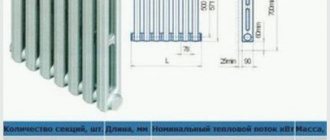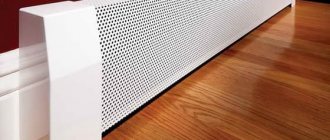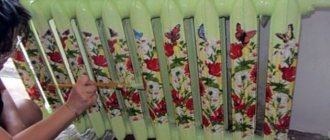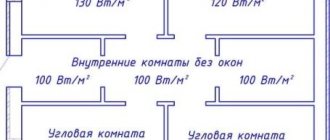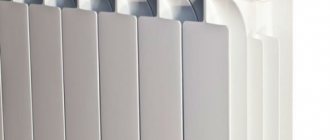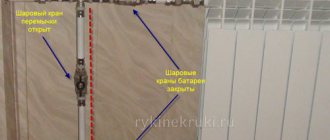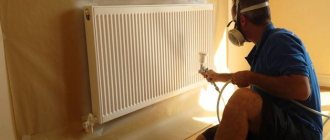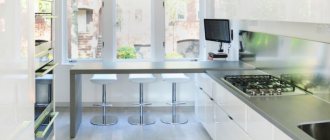A little about heat engineering and radiator grilles
Even if you need radiator grilles for decoration, do not forget that the radiators must heat the room. Any screen reduces heat transfer, even the most delicate and delicate one. Another question is that one will reduce the amount of heat transferred by 10-15%, and the other by 60% or even more. It is unlikely that you will want to sit in a beautiful but cold room, so when choosing a decorative grille you need to take into account how the heat will spread.
Heat Spread
The principle of heat transfer from a heating radiator without a grille is shown in the figure. The main idea is that air should come from below, pass along the battery, heat up, and go up. This is how our heating works. When choosing a grille or screen, you need to remember this. For normal air circulation, it is necessary that there is a gap at the bottom and no cover at the top. As a last resort, the lid should have a large perforation area.
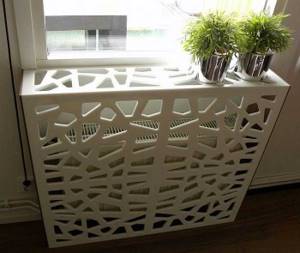
Not a bad option - large holes allow air to move freely
But if you look at many of the decorative grilles, you can immediately tell that the room will be cold. This especially affects grilles on heating radiators in the form of a box, which have walls on all sides. If they are very lacy, as in the photo above, there is no particular problem, but if they are made of solid wood (as in the photo below), with almost no or minimal perforations, be prepared for heating inefficiency.
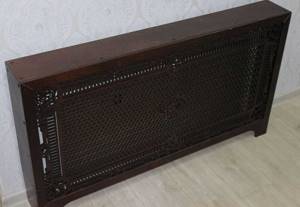
The top of the battery is covered with a solid layer of wood without holes
Wood is, of course, an aesthetic material, but it has a high heat capacity. Until the wood heats up, the room will be cold. And since the array is located above the radiator and there are no holes for circulation, the radiator under such a grille will be hot, but the room will be cold.
Types of decorative grilles
The main purpose of the grilles is to hide the surface of the radiator. But at the same time, they should not prevent air from circulating in the room. At the same time, they also perform a protective function.
One of the mandatory conditions that must be observed when installing the grille is simple dismantling, so that in case of maintenance or repair, it can be easily removed.
Today on sale there are radiator grilles made of various materials:
- wood;
- metal;
- stainless steel;
- thin plastic;
- aluminum;
- MDF.
Wood
Wood gratings are not cheap, since they are made from oak and beech, and these tree species are quite expensive, but the quality of the products made from them is appropriate.
Wooden grilles fit harmoniously into any interior and add sophistication to it. Despite the fact that such devices are reliable and durable, over time they can become deformed, because high temperatures have a negative impact on wooden products
Therefore, it is especially important to pay attention to the type of wood used in the manufacture of the grille. It is important that when heated it does not release resin
The most suitable are deciduous trees. In order to reduce the amount of moisture, the workpiece must initially be thoroughly dried. After this, be sure to treat it with an antibacterial compound to prevent the appearance of mold and various parasites in the fibers of the trees, then assemble the structure and cover it with paint and varnish.
Wooden trellises can be created by hand. This is very convenient, because... You will be able to completely design the carving and get a unique product made to your liking.
Do not buy grilles that are made in a “handicraft” way, because if the manufacturing technology is made with flaws, the attractive appearance of the product will quickly deteriorate.
Decorative grilles for batteries made of beech and oak
MDF
As already noted, not everyone can afford wood gratings.
If you want to save money, but at the same time want to have a high-quality coating for radiators, then you should pay attention to grilles made of MDF. This is a more budget-friendly option for radiator coatings
MDF tolerates moisture and high temperatures well.
Just as in the case of wooden grilles, you can choose any pattern and such a coating will be an excellent addition to the interior.
https://youtube.com/watch?v=ZEaU-3-Z8kY
Steel
This material is in greatest demand and today there are many variations in the manufacture of steel gratings.
Usually they make a frame-type steel radiator grille with their own hands. For this, ferrous or galvanized metal is used. But stainless steel panels are produced in factories.
When choosing a steel grille, do not forget to check the method of painting the body. It is preferable that it be made using powder technology (baking). The advantage of this coating is that it does not change color when heated.
Forged elements are also used to decorate the interior.
Stainless steel radiator screen
Plastic
This material is the cheapest, but not the most reliable, since such a coating will inhibit the flow of warm air masses. The material tolerates high temperatures well. However, remember that a large amount of heat will be lost.
Plastic gratings are created from PVC-based compounds. If the manufacturing technology is followed correctly, the coating will be able to withstand temperatures up to 95°C, and the appearance will not be affected.
The main advantages of such coatings:
- acceptable price;
- wide selection of shapes.
But! If we compare plastic protective screens for radiators with wood and steel, the former will lose their attractive appearance before others.
Plastic screens for batteries
Glass
Glass decorative grilles for heating radiators look beautiful and expensive in appearance, but their price is appropriate. Such battery screens are made from colored or frosted glass. There are copies with drawings on sale.
This material is not very practical. This is due to the fact that glass does not always resist mechanical shock. Therefore, you need to be extremely careful with such material.
Decorative screen for a heating radiator made of glass
Tasks and materials
Most often, grilles are installed on heating radiators for decoration - not all heating devices look attractive, but the grilles are sometimes made very beautiful. The second task that battery screens often perform is to cover sharp and hard edges. This is relevant in families with children, especially if old-style cast iron radiators, the “accordion” type, are installed. Their shape is dangerous, and their appearance is unattractive; they would only be suitable in loft-style rooms.
Grates for heating radiators are made from different materials:
- Metal screens for batteries are produced in large quantities. They are made from thin sheet steel, which is then coated with paint. For the most part, they don't cost much, but they also look average. The service life depends on the quality of the paint. Powder enamels are preferable. They last longer, maintaining their attractiveness for decades. From the point of view of the effect on heating, metal screens for radiators are the best choice. The metal heats up quickly, and then it begins to radiate heat. So the option is inexpensive (usually) and does not greatly affect the temperature in the room (if there is perforation).
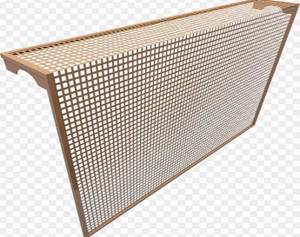
The most common form, and the design can be anything - Forged grilles are very beautiful. But the forging is too delicate, so some kind of background is required, and it is often made contrasting in order to highlight the forged elements more clearly. To ensure normal air circulation, it makes sense to make the “background” from a perforated metal sheet.

The forging is very beautiful - Wooden grilles and screens. Wood has always been and remains a premium material. The high plasticity of the material allows them to be made in different styles and shapes. And although there are inexpensive products made from wood, they look very good. But, as mentioned above, a radiator covered on all sides with wood transfers little heat to the room.
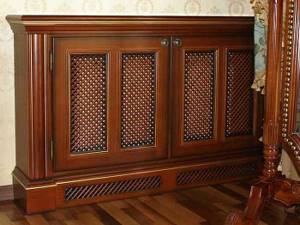
Wood always looks solid - MDF and HDF. For production, laminated sheet materials are used. Staz should say that no binders are used in the production of MDF and HDF. The softened wood fibers are pressed, releasing lignin, a natural binder found in wood. Lignin is what glues fibers together. So both of these materials are absolutely safe. While we know products made from MDF more or less well, HDF is an unfamiliar material for many. It differs from MDF only in the pressing conditions. It is molded under higher pressure, as a result it is very thin (3-4 mm), but more dense and uniform. HDF holds its shape well, which is why openwork grilles for heating radiators are often made from HDF. From the point of view of their effect on heating, they are slightly better than wood - the layer is thinner, and there are usually more perforations.

Openwork decorative grilles for batteries are usually made from MDF and HDF - Plastic. Plastic products are most often used in bathrooms and toilets. This material is the most hygienic; it can be washed an unlimited number of times. For production, heat-resistant plastic is used, which is not afraid of heating up to 60-80°C. If the grill slats are installed at an angle, as in the photo, the heating will work efficiently. Air flows through the cracks unhindered. It all depends on how the lid is made.

Plastic washes well, is durable and unpretentious - Glass screens for radiators appeared several years ago. They are not ideal from a heating point of view, but they have an attractive appearance. They are made from special tempered glass, frosted or patterned.
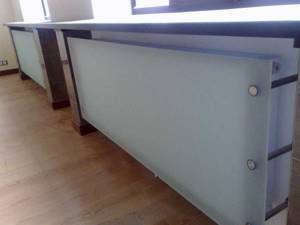
Screen for glass radiators
Used in the manufacture of decorative grilles for radiators and more exotic materials. For example, bamboo and rattan. Such products are more demanding for interiors and are rare.
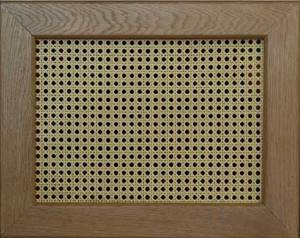
Rattan screen on wooden frame
There are also combined grilles. Most often there is a wooden frame on which some kind of decorative mesh is stretched. Bamboo and rattan wickers are most often attached to such a frame. MDF and HDF panels are usually mounted on a wooden frame.
Varieties
The main feature that you should pay attention to when choosing a grille is that the decorative element in the design should not create any obstacles to the heat exchange path. Protective screens are usually divided into 2 types - a simple box (designed for protruding or mounted radiators) and a panel type (designed for radiators that are hidden from view in a special niche or hidden in the floor)
The most popular materials from which gratings are made are:
- rattan;
- tree;
- metal;
- plastic;
- medium and high density fiberboard;
- glass.
Let's look at some of them. Many would not even think that glass can be used as a screen for radiators, because you rarely see this. But glass is a very successful material. For screens, choose the option with a thickness of 8-10 mm, since the density of such glass is very high and it is difficult to break them. The cut edges are processed and polished for safety, and the surface itself is covered with a special protective film that is not afraid of moisture and heat, so the glass is not afraid of wet cleaning. Such screens have many positive aspects:
- high heat transfer;
- fit harmoniously into the interior and can cover even the most unsightly radiators;
- You can choose any design on the glass; it can be photo printing, paint or adhesive paper.
Typically, metal screens are made in the form of a rectangle with a border, and in the middle there is a large or small mesh. It can be made with a certain ornament or made in the form of a continuous canvas. The difference that occurs between metal gratings is the presence or absence of side walls. This factor does not affect heat transfer in any way; it simply acts as a decorative element in the interior.
Metal gratings are famous for their high heat transfer and ease of cleaning. When using such screens, your radiator will not become contaminated with dust, since the gaps in the grille are too small. Wooden screens are one of the oldest ways to hide a battery from view. Now they are in demand among those people who love eco-style.
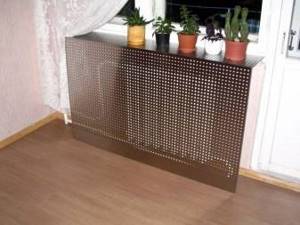
The wood most often used to make convector grilles is oak or bamboo. This grille is painted with a special varnish so that it does not dry out and is not deformed over time from heat. Environmental friendliness is the biggest plus, which can surpass all the convenience of other materials. Therefore, such screens are common in children's institutions or hospitals. Another positive point is that wood “breathes,” which means it will transmit heat very well.
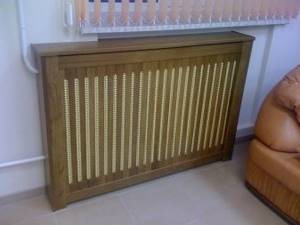
Plastic screens are usually used for radiators built into niches. Such gratings are made in the shape of a small rectangle. It is mounted into the surface of the floor or window sill, and all heat exchange occurs through it, since the battery itself is completely hidden behind the wall or under the parquet. The main disadvantage of plastic grilles is that if the plastic is of poor quality, then when heated at high temperatures it will begin to melt and emit an odor harmful to human health. Therefore, such structures are usually installed in office premises, where people are not present around the clock. This option is not suitable for home.
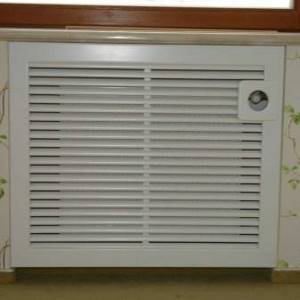
Another type of grille for convectors is the roll type. They are usually made:
- made of aluminum;
- made of natural wood or bamboo;
- made of metal (stainless steel).
Roller grilles are divided into 2 types.
- With cross slats. With this option, the grille can be rolled into a roll.
- With rigid longitudinal or diagonal slats. In this case, it will not be possible to roll up the structure.
Types and forms
In addition to different materials, radiator grilles come in different designs. All this together creates a huge number of options.
- Flat screens. Most often used if the radiator is installed in a niche. In this case, the flat panel is attached to bars fixed around the perimeter of the niche. In addition, glass screens for batteries also have this shape, but are attached to special pins embedded in the wall. This type of decorative grille for heating radiators is also called “facades”.
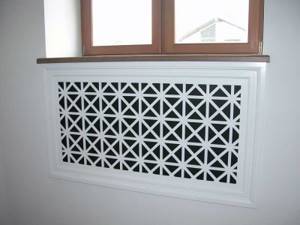
Flat screens are installed if the radiator is hidden in a niche - Hanging screens. There are two types: With a top cover. They are usually used on accordion-type batteries if the radiator protrudes beyond the window sill. The shape of the cover is made so that the grille holds onto the radiator without any problems.
- Without cover. Clings to the upper battery collector using hooks that are attached to the front panel.

Hanging grilles
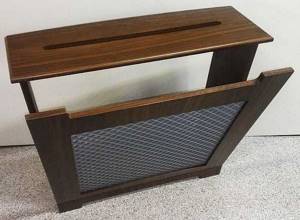
Attached grille-box for radiator
These are only the main types of screens and grilles covering heating radiators. Fantasy is limitless, there are very interesting models, but they are most often made by craftsmen with their own hands.
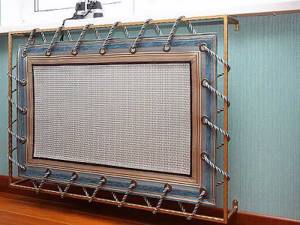
Homemade screen - an original idea
Price often plays an important role when choosing a screen for a radiator. The range of prices in this segment is more than significant - from 230 rubles for a metal hinged screen, to 8,000 rubles for a glass one. Some prices are shown in the table.
| Radiator grille material | View of the grille on the heating radiator | Dimensions (height*width*depth) | Price | Color |
| Sheet metal, thickness 0.7-0.8 mm | Hinged screen for a cast iron battery | 27 cm * 29 cm * 15 cm | 230 rub. | White |
| Sheet metal, thickness 0.7-0.8 mm | Hinged screen for steel radiator | 44 cm * 39 cm * 15 cm | 250 rub. | White |
| Sheet metal, thickness 0.7-0.8 mm | Hinged screen for a cast iron battery | 61 cm * 49 cm * 15 cm | 280 rub. | White |
| Sheet metal, thickness 0.7-0.8 mm | Hinged screen for steel radiator | 53 cm * 49 cm * 10 cm | 350 rub. | Beige |
| MDF | Facade (flat screen) | from 1500 rub | 7 shades of lamination | |
| MDF | Box | from 2300 rub | 7 shades of lamination | |
| Glass | Screen | from 8000 rub | matte, no pattern | |
| Powder coated metal | Wall mounted with one side | 60 cm * 40 cm * 15 cm | 1790 RUR | colors upon request |
| Powder coated metal | Wall mounted with one side | 70 cm * 60 cm * 15 cm | 2050 rub. | colors upon request |
| Powder coated metal | Wall mounted with two walls | 60 cm * 40 cm * 15 cm | 2340 rub. | colors upon request |
| Powder coated metal | Wall mounted with two walls | 70 cm * 60 cm * 15 cm | 2600 rub. | colors upon request |
| Natural wood | Pristavnoy | from 6200 rub |
Do-it-yourself installation of a plasterboard box
In order to close the battery, you need to measure it, and then buy metal profiles and other additional products.
What materials are needed:
- 12 mm plasterboard sheet,
- metal profiles 27x28 and 60x27,
- self-tapping screws for drywall and metal,
- dowel-nails size 6x40,
- construction serpyanka,
- perforated corners.
Tools:
- screwdriver,
- hammer drill,
- metal scissors,
- stationery knife,
- construction stapler,
- pencil,
- roulette,
- building level.
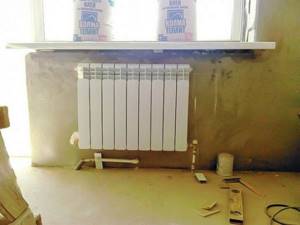
Mounting features
Grilles on heating radiators must be mounted in such a way that you can easily and quickly access heating appliances and pipes. Periodically, at least twice a year, the heating system elements must be cleaned of dirt and dust, so access is necessary. In addition, emergencies arise from time to time. In this case, a quick reaction is required and there is no time to unscrew the fasteners. Therefore, try to come up with a fastening system that allows you to remove the screen in one motion.
Attached and mounted
The easiest way is with mounted or attached screens. They are removed/retracted in seconds. But flat, covering radiators in niches and box screens that are attached to the wall are the most problematic. But even here everything is solved simply. You can secure the box to the wall using two strips: one on the box, the second on the wall. The whole secret is that the top edge of the planks is beveled (you can see it in the picture). The one that is nailed to the wall has a slope towards the wall, the one on the frame has a slope towards the grating. When the box is installed in place, it turns out something like a lock.
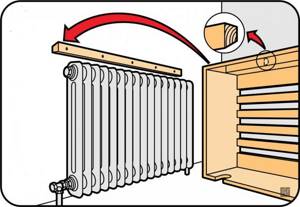
How to fix a screen box for a heating radiator on the wall
Another option is to attach metal plates to one of the strips and magnets to the other. Or attach not a wooden plank to the wall, but a metal corner, for example.
In the case of flat screens, the solution may be the same - metal plates and magnets. Another option is hooks and loops. It is easy to implement, but not very convenient to use: while you get into loops, you have to suffer. There is also a difficult-to-install but convenient way: make a screen like a sliding door.

Sliding screens for radiators
You can take the guides that are sold for furniture doors, install them, and insert the screens into the corresponding grooves. If you do not plan to actively use the niche near the battery, you can not install roller mechanisms, but it will be difficult to move them away. This method, by the way, can also be used for the box lattice. It can then be nailed “tightly” to the wall, and the front wall can be made movable.
How to properly install a screen behind a radiator
So, the heat transfer of radiators increases significantly if a heat-reflecting screen is placed on the wall behind them. Its installation will not cause any difficulties even for a novice home craftsman.
When purchasing material to perform this work, pay attention to the fact that its reflective surface is not matte, but polished. When installing the screen, do everything possible to ensure that there is an air gap of about 2 cm on both sides of the heat insulator, guaranteeing heat retention in the interior of the room
To install the heat-reflecting screen, you can use liquid nails or regular wallpaper glue. When cutting out a heat insulator, you should remember that its area should exceed the size of the battery by approximately 10%. This ensures greater efficiency of the installed screen.
When everything is ready, you can proceed directly to installing the product, performing work in the following sequence:
- remove the radiator and its suspension brackets, having previously marked their attachment points;
- inspect the exposed wall, if necessary, putty or plaster it in order to eliminate the defects found there and level the surface;
- stick the screen;
- install brackets, hang and connect the radiator.
After performing the described operations, the heat transfer from the radiators in your apartment will increase significantly. You can be sure of this when the next winter comes and when the heating is turned on again.
R.S.
Among our readers, there are probably experts who have a deeper knowledge of the intricacies of this issue. We will be glad and grateful if you leave some corrections and clarifications in your comments.
Interesting design options for battery screens: photo ideas
In addition to the technical side of the issue, the aesthetic side is no less important. There are grille and screen options that are more of a design element rather than a technical detail. Some of them are in the photo.
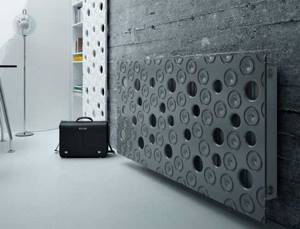
The decorative panel that covers the radiator itself looks like the work of an avant-garde sculptor
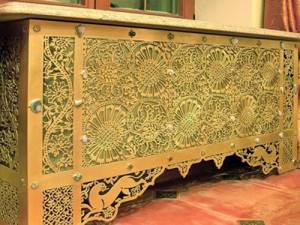
Looks like a chest from a fairy tale. This is made using laser cutting

Openwork always looks attractive
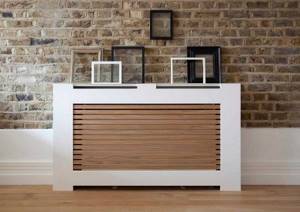
Option for designing grilles for heating radiators in a modern style
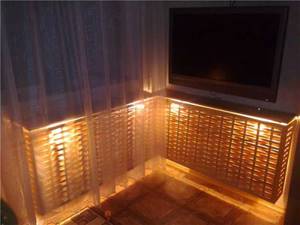
Making a backlight is an original idea
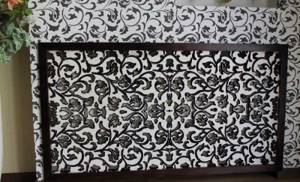
Repeating the pattern on the wallpaper is a stylish solution
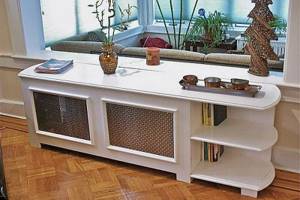
Make not just an attached box, but a functional thing
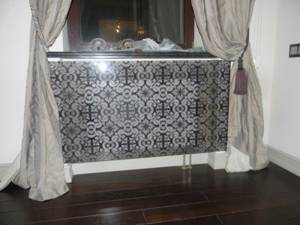
Glass screens can have any design, be it a landscape, an ornament, even your personal photo
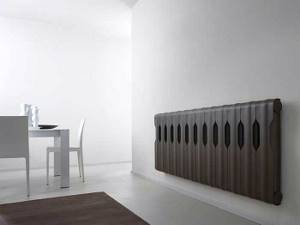
A stylish version of a metal screen for rooms in minimalist and high-tech styles
Element importance
The radiator grille is needed to add sophistication to the interior, but the screen on the battery should not reduce heat transfer. It is believed that even the most delicate and thin radiator grille still reduces the amount of thermal energy transmitted by the radiator. It is unlikely that a beautifully decorated but cold room will be comfortable, so choosing a decorative grill option is an important aspect.
The main method of heating from a radiator is that the heat must move from below, and then go up along the radiator. Most heating systems operate on this principle, so the selected radiator decor should not interfere with classic circulation.
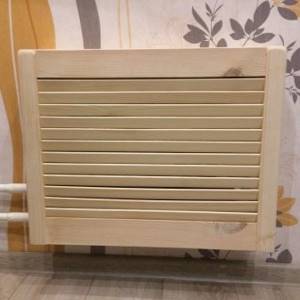
If the screens are ideally selected and installed correctly, they will not only provide a good appearance to the room, but will also direct heat in the right directions. Therefore, radiator grilles sometimes contribute to better efficiency of the heating elements.
The importance of the element also lies in the fact that it plays the role of protection against overheated radiators. Touching hot devices is not safe for small children - this is a positive argument in favor of using decors of this kind
Cast iron radiators are often considered inappropriate in rooms. The screen for cast iron batteries is most often used. The method of replacing old cast-iron heating devices with beautiful modern options is considered the most difficult. The task is greatly simplified with the use of a shielding device or protective box.
There are many companies that manufacture screens. The number of different elements is also multifaceted. Many people try to make exclusive handmade versions of their products on their own.
In handicraft devices, the manufacturability of the process is not taken into account, so the products often turn into an obstacle to the passage of warm air.
This is allowed if the house is private, since the heat will still return, but to another room. If the house is multi-story, then the heat will flow through the riser to the neighbors.

In addition, a handicraft product is unlikely to be made from the optimal material, while dozens of varieties of factory products differ not only in shape, but also in the material of manufacture, which will provide good conditions for a particular room.
The importance of installing screens on radiators can be summarized with the following points:
hide radiators that spoil the design of the room; play the role of an additional decorative element, so it is important to choose appropriate materials; protect batteries from debris getting into them, so it is necessary to provide the exact dimensions of the screen; are protection for children from burns and injuries, especially if the batteries are cast iron.


